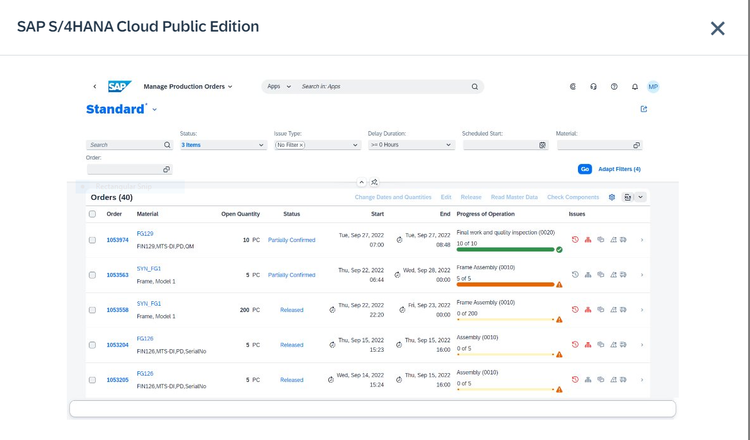ERP Data Management: Best Practices and Key Features
ERP software data management refers to the processes and methodologies used to collect, store, maintain, and interpret data within an ERP system. These systems integrate various business functions, such as finance, human resources, procurement, and production, into a unified platform.
Efficient data management is a critical component of ERP software as it ensures accurate, consistent, and easily accessible information for decision-making, reporting, and business analytics.
Best Practices
Maintain data accuracy, quality, and accessibility through these best practices and strategies:
-
Effective Data Migration: Migrating data into an ERP system demands meticulous planning and validation to ensure data accuracy and completeness. You should test the migration process in a controlled environment before the actual migration and validate data in the ERP system to ensure it matches the source data. Learn more in our ERP Data Migration Steps and Best Practices guide.
-
Data Quality Assurance: Establish regular data cleansing and validation processes to consistently uphold data quality. Continuously monitor data for anomalies or deviations from established quality standards. Implement alerts and notifications for data quality issues.
-
Business Context Groupings: Categorizing data based on business context simplifies data retrieval and analysis, bolstering decision-making capabilities. For example, customer, product, and sales data can be organized into distinct categories. Establish a taxonomy or hierarchy for data categories to provide a clear structure.
-
Data Integration: Ensure seamless integration between ERP modules and other systems within the organization. Use standardized data formats and APIs for data exchange. Implement data synchronization and real-time data updates where necessary.
-
Monitoring and Reporting: Implement monitoring tools and dashboards to track ERP data performance and quality. For management review, generate regular reports on data usage, quality, and compliance.
-
Data Retention: Define data retention policies in compliance with industry regulations and business needs. Archive historical data that is no longer actively used but may fulfill reporting or compliance requirements.

Key Features
-
Matching and Linking Functionality: Offers strong capabilities to match and link data from diverse sources, eradicating duplicates and safeguarding data integrity.
-
Data Visualization: Enables users to craft insightful charts, graphs, and dashboards, facilitating data-driven decision-making.
-
Analytics and Reporting: Provides capabilities for data analysis, including dashboards and data visualization. They also support ad-hoc reporting for custom data exploration.
-
Data Localization: Supports multiple languages, currencies, and regional regulations, empowering businesses to operate seamlessly globally.
-
Metadata Management: Involves cataloging and documenting metadata to provide context and understanding of data elements. It also includes support for metadata-driven data transformations and data lineage tracking.
-
Data Enrichment: Integrates external data sources, augmenting the depth and quality of information.
Primary Benefits
-
Data Consistency: Consolidates data from various departments and sources, eliminating data silos. This ensures that all employees work with the same data set, reducing the risk of inconsistencies and errors often arising from disparate data sources.
-
Data Security: Enables granular control over who can access, modify, or delete specific data. Role-based access controls and permissions ensure that only authorized individuals can interact with sensitive information.
-
Increased Revenue: Offers insights into customer behavior and market trends, enabling businesses to identify opportunities for cross-selling, upselling, and personalized marketing campaigns. The result is increased sales and revenue growth.
-
Boosted Productivity: Automates routine tasks, curbing manual data entry and paperwork. This automation liberates employees to focus on more value-added activities, thus elevating overall productivity.
-
Supply Chain Management: Provides real-time visibility into inventory levels, order status, and supplier performance. This capability empowers companies to optimize their supply chain operations, reduce costs, and elevate customer satisfaction.
-
Improved Customer Experiences: Empowers businesses to provide exceptional customer experiences. It ensures accurate and timely order fulfillment, addresses customer inquiries promptly, and personalizes interactions based on customer data.
-
Vendor Management: Streamlines vendor performance tracking, payment processing, and collaboration, cultivating better relationships and cost savings.

Where is ERP Data Stored?
ERP data is typically stored in databases. The location and method of storage will depend on the ERP system’s architecture and deployment model.
-
On-Premises ERP Systems: For traditional on-premises ERP systems, the data is usually stored in databases in a company’s data center or server room. Examples of such databases include Oracle, Microsoft SQL Server, and IBM Db2.
-
Cloud-Based ERP Systems: For cloud-based ERP systems (like NetSuite, SAP S/4HANA Cloud, or Microsoft Dynamics 365), the data is stored in databases managed by the ERP vendor or a third-party cloud service provider. These databases reside in data centers operated by the cloud provider, and they ensure data accessibility, security, and backups.
-
Hybrid ERP Systems: In hybrid models, some ERP data might be stored on-premises while others are in the cloud. This offers a balance between control and flexibility.
-
Database Technology: ERP systems can use relational databases (like MySQL, PostgreSQL, Oracle, or Microsoft SQL Server), or in some modern cases, they might use NoSQL databases or a combination of both, depending on the requirements and nature of the data.
-
Backup and Disaster Recovery: Apart from the primary storage, ERP data is regularly backed up to ensure data integrity and availability. Depending on the organization’s backup and disaster recovery strategy, this can be to local storage devices, off-site locations, or cloud storage.
FAQs
-
What advantages do cloud environments offer for ERP data management? Cloud environments provide advantages like greater scalability, flexibility, and accessibility for ERP data management. They allow for easier data sharing, backup, and disaster recovery. Hybrid and multi-cloud solutions enable seamless data flow across diverse cloud environments, enhancing data management capabilities.
-
How can AI integration benefit ERP data management in the future? AI integration in ERP data management can automate data categorization, predictive analytics, and anomaly detection tasks. This can lead to more efficient data processing, better insights, and improved decision-making.
